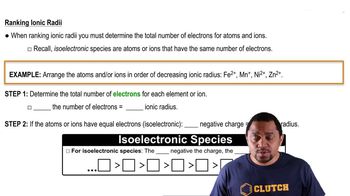Textbook Question
Identify each statement as true or false: (a) Cations are larger than their corresponding neutral atoms.
 Verified step by step guidance
Verified step by step guidance


Identify each statement as true or false: (a) Cations are larger than their corresponding neutral atoms.
Identify each statement as true or false: (b) Li+ is smaller than Li.
Identify each statement as true or false: (c) Cl- is bigger than I-.
Use data from Appendix C, Figure 7.10, and Figure 7.12 to calculate the lattice energy of RbCl.
Which neutral atom is isoelectronic with each of the following ions? Ga3+, Zr4+, Mn7+, I−, Pb2+.
Some ions do not have a corresponding neutral atom that has the same electron configuration. For each of the following ions, identify the neutral atom that has the same number of electrons and determine if this atom has the same electron configuration. (a) CI−, (b) Sc3+, (c) Fe2+, (d) Zn2+, (e) Sn4+.